D-51during the Apollo mission. The Hartung interpretation has, however, some inconsistencies,which make the Tapanui interpretation more valid. These inconsistencies are as follows:(a) Monks claimed that the moon was apparently writhing and throbbing. Of course,no meteorite could cause such a motion of the whole moon with its effects observable bythe naked eye on Earth. It is more feasible that such apparent motion was caused byshockwaves spreading through the Earth's atmosphere. But the meteorite is claimed tohave hit the moon, not the Earth.(b) The moon does not have any atmosphere which is necesssary to produce flamesand explosions.(c) The meteorite was supposed to hit the moon on the other, black side. Thus howwas it possible that the monks saw fire on the Earth's side?(d) Because a string of meteorites hitting the moon in sequence, and leaving only asingle crater, should be excluded from consideration, it is difficult to understand how asingle meteorite could possibly cause a sequence of six or more explosions observed insuccession by the monks.Of course, in spite of the above inconsistencies, there will still be people who adhereto the Hartung interpretation because there exists the relatively new Giordano Bruno crater,discovered by the high-tech Apollo mission. These people should realize that from theevidence point of view, the existence of the Giordano Bruno crater has less merit then theexistence of the Tapanui Crater. This is because all other means of dating (independent ofthe above interpretation) of the moon crater are more errorprone than such datingcompleted for the Tapanui Crater.D2. Evidence for the global climate change around 1178The consequences of the Tapanui explosion can be observed not only in NewZealand, but throughout the entire globe. One of the researchers whose findings supportthe author's hypothesis about the global impact of this event, is a New Zealand botanist,John T. Holloway. In his treatise "Forests and Climate in the South Island of New Zealand"(Technical Paper No. 3, Forest Research Institute, New Zealand Forest Service, September1954) he completed an in-depth analysis of the New Zealand climate arriving at the finalconclusion that around the time of "Fires of Tamaatea" there was a rapid and significantclimate change extending not only to this country. To reinforce this conclusion he presentsthe evidence that before 12th century the South Island of New Zealand was covered withtotara bush, and also that kumara (sweet potato) were cultivated there, both currently thriveonly in the upper part of the North Island. The rapid and significant cooling of New Zealandthat occurred around 1200, Holloway links with the global climatic changes, as theexistence of the Tapanui explosion was unknown to him. This is what he has written onpage 373 of his treatise: "If the date for the climate change be set at about 1200 A.D., thenthis agrees, as pointed out by Raeside, with the agreed dating of the last major climatechange in Western Europe and in the North Atlantic region generally; and most authoritiesappear to agree that temperature changes, rainfall changes being secondary andconsequential, occur synchronously in both hemispheres". In this quotation Holloway refersto the historically documented fate of the Norwegian Viking colony in Greenland.The greatest paradox of the Tapanui explosion is that its main victims were Vikingsliving on the opposite side of the world from New Zealand. Before the Tapanui explosiontook place, the epoch of warm climate prevailing in the northern Europe combined with theextremely convenient geographical location of Scandinavia, provided ideal conditions forthe development of Vikings. Starting from about the year 793 war fleets of these warriorsand explorers began to expand outwards. They successfully raided England, France,Poland, and Russia. By 1178 the sphere of the Vikings' influence and expansion extendedfrom the present Canada, through all northern islands of the Atlantic Ocean, to Europe
D-52including Mediterranean and Bizancium. But the Tapanui explosion brought disastrousclimatic changes which undermined the roots of Vikings' existence. Soon afterwardsScandinavia became cold and icy placing environmental constraints into the survival andcontinuation of Vikings population. Also most of the sea routes they followed become frozenover and non-accessible. Thus the climatic consequences of the Tapanui explosionreversed Viking expansion, causing the gradual downfall of these adventurous people.The fate of the Norwegian colony in Greenland is a kind of condensed parable thatallegorically illustrates the doom of all Vikings. This colony was established by Eirik the Redin 982 A.D., when Greenland was green, thriving with life, and completely unpopulated.From an initial 450 souls in 982 it grew into some 3000 Norsemen around 1178. It declaredits own independence, built a cathedral, and settled small sub-colonies at what presently isthe territory of Canada and the USA. But the Tapanui explosion triggered global climaticchanges which gradually turned Greenland into an icy desert. These changes are confirmedby research, and well reflected in literature. Provided below are two quotations which givesome idea about their progress and effects. The first of these quotations, taken from thebook by Gwyn Jones "A history of the Vikings" (Oxford University Press, London, 1968,page 307), says: "The great voyages of Eirik the Red, Leif, and Karlsefni all took place at atime when the northern lands and seas were enjoying a comparatively favourable climate.But after 1200 it began to grow colder, and by the middle of the fifteenth century it was verycold indeed". The second quotation, taken from the book by Jacqueline Simpson "Everydaylife in the Viking age" (B.T. Batsford Ltd., London 1967, page 42), says: "It must be addedthat many climatologists believe that up to about 1100 the climate was warmer in thoseregions than it is today; the seas must have been freer of ice, and the conditions morefavourable for cattle-raising". The deterioration of Greenland's climate had three mainimplications for the Viking settlers there: (1) it prevented them from growing their own food,(2) it cut Greenland off from easy sea access to Norway, and (3) it created a link withCanada via ice, which allowed hostile Eskimo people to invade Greenland and graduallyannihilate Vikings there. By 1410 only a few Norwegian settlers in Greenland were stillalive, whereas a ship arriving there in about 1540 found the body of a single dead man lyingface downwards in the dust (see the book by Ole Klindt-Jensen, "The World of the Vikings",Allen & Unwin, London 1970, page 81).While the Tapanui explosion terminated and reversed expansion of Vikings, itseemingly raised the Mongolian empire. Some historians hypothesised that the rapiddroughts, which struck steppes of Mongolia exactly at the time of the Tapanui explosion,were the direct cause for the most famous medieval warrior-ruler, Genghis Khan (born1162, died 1227 A.D.), to raise to power and to extend his empire from China to Europe'sAdriatic Sea. "The New Encyclopedia Britannica" (Macropaedia, Volume 19, fifteenthedition, 1986) even tries to polemize with the hypothesis of these historians. This is whatthe Encyclopedia says on page 746 under the topic "Genghis Khan": "Nor is it true, assome have supposed, that these campaigns were somehow brought about by a progressivedesiccation of Inner Asia that compelled the nomads to look for new pastures." Although, inthe opinion of Macropaedia authors, the mentioned Asian droughts were not responsible forthe expansion of Mongols, this quote acknowledges that some historians have linked thehistoric records of these draughts with the formation of the Genghis Khan empire. Ofcourse, it is not the intention of this monograph to judge if there is a link between these twoevents; the above quote is only to show that the Tapanui explosion triggered a whole chainof climatic changes having global significance and consequence.Simultaneously with steppes of eastern Asia significant climatic changes wereoccurring also in Japan. It is historically documented that shortly after the Tapanui explosiona number of unusual typhoons occurred in the Japanese Sea. Because such typhoonshelped to defeat two approaches of the Mongolian (Genghis Khan grandson's) army whichtried to invade Japan, it was at that time when the term "Kamikaze" (i.e. the "Divine Wind")was coined.
- Page 1 and 2:
Proof Copy ([5e/3] reformatted to P
- Page 3 and 4:
3G-83 G. Evidence certifying that M
- Page 5 and 6: 5Notes:(1) Before this monograph wa
- Page 7 and 8: A-2or disk"). The information which
- Page 9 and 10: A-4immune deficiency, thus it is qu
- Page 11 and 12: A-6edition, 1986) even tries to arg
- Page 13 and 14: A-8changes have no connection with
- Page 15 and 16: A-10Fig. A2. The curved slope in th
- Page 17 and 18: B-12inspired me to suspect that hum
- Page 19 and 20: B-14Earth by evil UFOnauts God trie
- Page 21 and 22: C-16#10. The spread, radiating from
- Page 23 and 24: C-18"Te Ura-a-Te Raki-Tamau", which
- Page 25 and 26: C-20item #2 that follows). Thus, in
- Page 27 and 28: C-22comparative data which reflects
- Page 29 and 30: C-24exploding fires, columns of fir
- Page 31 and 32: C-26banks of the Black Gully Creek,
- Page 33 and 34: C-28meditating, conducting healing
- Page 35 and 36: C-30deaths of people with symptoms
- Page 37 and 38: C-32(1) The Kawakawa volcano erupte
- Page 39 and 40: C-34The Tapanui Crater is the centr
- Page 41 and 42: C-36Fig. C2. The inner topography o
- Page 43 and 44: C-38(a)(d)(b)(c)(e)Fig. C4. Example
- Page 45 and 46: C-40Fig. C6. The illustration of si
- Page 47 and 48: C-42Fig. C8. The distribution of in
- Page 49 and 50: C-44Fig. C10. Two photographs of a
- Page 51 and 52: C-46Fig. C12. The location of near-
- Page 53 and 54: C-48Fig. C14. A magnetized metallic
- Page 55: D-50Chapter D:EVIDENCE THAT THE TAP
- Page 59 and 60: D-54rapidly released by this explos
- Page 61 and 62: D-56experiments, and many more. Thi
- Page 63 and 64: D-58that people were in medieval ti
- Page 65 and 66: D-60then continually resonates in t
- Page 67 and 68: D-62"tapanui.htm") are to be met, s
- Page 69 and 70: D-64when such abnormalities of the
- Page 71 and 72: E-66Chapter E.HYPOTHESES EXPLAINING
- Page 73 and 74: E-68is directed towards the magneti
- Page 75 and 76: F-70publication of this design and
- Page 77 and 78: F-72can be built, each type taking
- Page 79 and 80: F-74sites an explosive growth of mu
- Page 81 and 82: F-76F4. Explosion sites of the Magn
- Page 83 and 84: F-78- Deficiency of some sensitive
- Page 85 and 86: F-80(a)…(b)…(c)Fig. F2. The des
- Page 87 and 88: F-82Fig. F4. The explanation for a
- Page 89 and 90: G-84The formal proof that "UFOs are
- Page 91 and 92: G-86civilization(s) sending UFOs mu
- Page 93 and 94: G-88the close proximity of the Tapa
- Page 95 and 96: G-90(c)(d)Fig. G1. Two photographs
- Page 97 and 98: G-92(a)(c)(b)(d)(e)Fig. G3. A spher
- Page 99 and 100: G-94(a)(b)(c)(d)Fig. G5. Pulsating
- Page 101 and 102: G-96(a)(b)(c)(d)(e)Fig. G7. Smooth,
- Page 103 and 104: G-98(a)(b)(c)(d)Fig. G9. Photograph
- Page 105 and 106: H-100#6. The Tapanui Crater is orie
- Page 107 and 108:
I-102Chapter I:MORAL ACCENTUATION O
- Page 109 and 110:
J-104explosion energy carrier would
- Page 111 and 112:
J-106detonation a number of appropr
- Page 113 and 114:
J-108resembled "china stones" from
- Page 115 and 116:
K-110Chapter K:AROUND 13 500 YEARS-
- Page 117 and 118:
K-112civilisation were prepared for
- Page 119 and 120:
L-114Chapter L:STILL ANOTHER UFO EX
- Page 121 and 122:
L-116Coincidentally, the author had
- Page 123 and 124:
M-118in section D3). This in turn h
- Page 125 and 126:
N-120Chapter N:TWELVE TRUTHS ABOUT
- Page 127 and 128:
N-122only factors which may cause t
- Page 129 and 130:
N-124ones who stand by truth and th
- Page 131 and 132:
O-126Chapter O:ACADEMIC ASPECTS OF
- Page 133 and 134:
O-128Galactic field, thus producing
- Page 135 and 136:
O-130specifically what was wrong wi
- Page 137 and 138:
O-132moral field causes that we acc
- Page 139 and 140:
O-134white glowing balls of playful
- Page 141 and 142:
O-136brought disgrace to that unive
- Page 143 and 144:
O-138the Polish language only, whic
- Page 145 and 146:
O-140occupation of Earth, and then
- Page 147 and 148:
O-142in a few years of time, when t
- Page 149 and 150:
O-144and both these matters were se
- Page 151 and 152:
O-146today. We need to realize this
- Page 153 and 154:
O-148Of course, the above history i
- Page 155 and 156:
O-150two kinds of resource publicat
- Page 157 and 158:
R-152Chapter R:AT THE END OF THIS M
- Page 159 and 160:
R-154forget that such paid scientis
- Page 161 and 162:
S-156Chapter S:REFERENCES COMPLEMEN
- Page 163 and 164:
S-158[7/2] Giordano D. and Pajak J.
- Page 165 and 166:
T-160Magnocraft exploded over New Z
- Page 167 and 168:
Z-162Appendix Z:Directions for gett
- Page 169:
Z-164Fig. Z1. The most educational


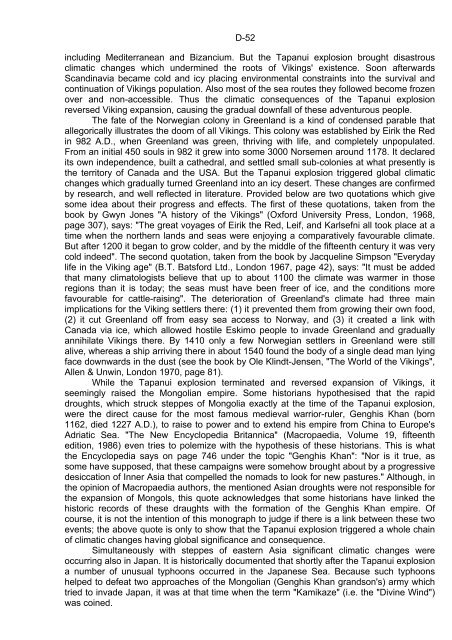




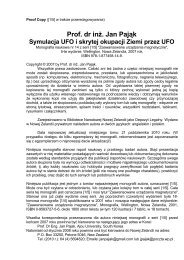


![[1/4p]: PDF - Totalizm](https://img.yumpu.com/45003232/1/184x260/1-4p-pdf-totalizm.jpg?quality=85)

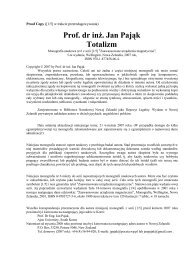
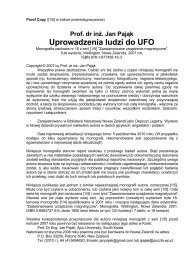
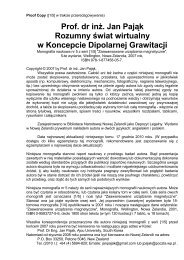
![[1/4p]: PDF - Totalizm](https://img.yumpu.com/39351336/1/184x260/1-4p-pdf-totalizm.jpg?quality=85)
